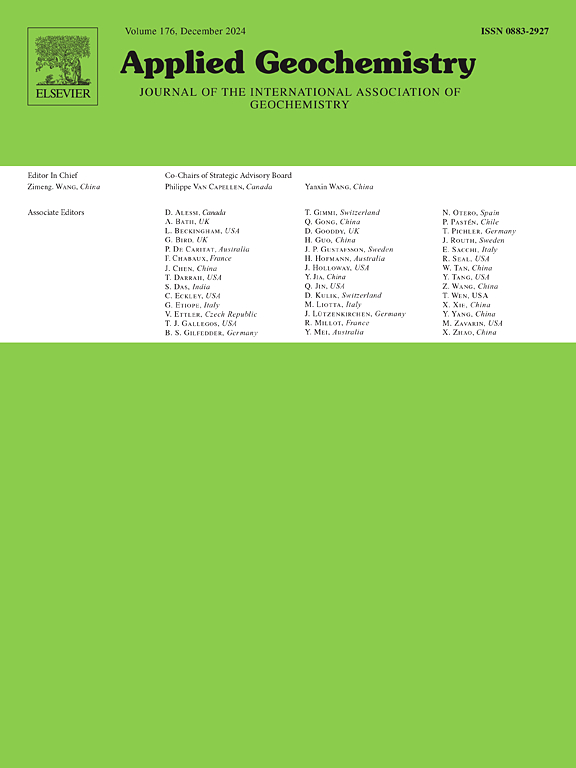The gangue sponge: implications for in-situ/heap leaching of chalcopyrite
IF 3.4
3区 地球科学
Q1 GEOCHEMISTRY & GEOPHYSICS
引用次数: 0
Abstract
As the demand for copper increases, processing increasingly low-grade ore has become a critical challenge. Most of these ores are dominated by aluminosilicate gangue minerals, among which Fe-bearing phyllosilicates are the most reactive. The effect of Fe-bearing minerals on the acid leaching of chalcopyrite, the most common primary Cu ore mineral was investigated by comparing mixtures of chalcopyrite with (i) chamosite, (ii) berthierine-chamosite, and (iii) pyrite. The lixiviant consisted of solutions with 0.1 m Fe2(SO4)3 + 0.3 m H2SO4, and the experiments were conducted in an orbital shaking water bath at 50 °C for 43 days. The solution pH increased and Eh decreased for all systems, resulting in conditions that became less optimal for Cu recovery. Scanning electron microscope imaging highlighted the porous nature and variable elemental composition of the (partially) dissolved phyllosilicate minerals/amorphous-silica-residue after leaching. Micro X-ray Absorption Near Edge Structure (μXANES) measurements revealed that sulfur exists in multiple oxidation states both within the silicate gangue and around chalcopyrite, emphasising how the formation of an amorphous-silica-residue increased the complexity of the system. This complexity is related to the fact that (partial) dissolution of phyllosilicate gangue minerals during acid leaching results in the release of ions that change the solution chemistry; and form an amorphous-silica-residue, that contains numerous pores. These pores can act as local micro-reactors with non-equilibrium conditions and promote a heterogenous chemical composition. Subsequent mineral surface-fluid interactions in (partially) dissolved phyllosilicate/amorphous-silica-residue pores can vary, depending on the local chemical composition, making the leaching behaviour of chalcopyrite highly dependent on local conditions and on the mineralogical composition of the ores.

脉石海绵:黄铜矿原位/堆浸的意义
随着对铜需求的增加,处理品位越来越低的矿石已成为一项严峻的挑战。这些矿石大多以铝硅酸盐脉石矿物为主,其中含铁层状硅酸盐活性最强。通过比较黄铜矿与(i)铁黄铁矿、(ii)铁黄铁矿和(iii)黄铁矿的混合,研究了含铁矿物对黄铜矿(最常见的原生铜矿物)酸浸的影响。溶液为0.1 m Fe2(SO4)3 + 0.3 m H2SO4,实验在50℃的轨道振荡水浴中进行,持续43天。所有体系的溶液pH值升高,Eh值降低,导致Cu回收条件变得不那么理想。扫描电镜成像显示浸出后(部分)溶解的层状硅酸盐矿物/无定形硅渣的多孔性和变化的元素组成。微x射线吸收近边结构(μXANES)测量显示,硫在硅酸盐脉石内部和黄铜矿周围以多种氧化态存在,强调了非晶硅渣的形成如何增加了系统的复杂性。这种复杂性与以下事实有关:在酸浸过程中,层状硅酸盐脉石矿物(部分)溶解导致离子释放,改变了溶液的化学性质;形成含有大量孔隙的无定形硅渣。这些孔隙可以在非平衡条件下充当局部微反应器,促进化学成分的非均质化。在(部分)溶解的层状硅酸盐/非晶硅渣孔隙中,随后的矿物表面-流体相互作用可能因当地的化学成分而异,这使得黄铜矿的浸出行为高度依赖于当地条件和矿石的矿物成分。
本文章由计算机程序翻译,如有差异,请以英文原文为准。
求助全文
约1分钟内获得全文
求助全文
来源期刊

Applied Geochemistry
地学-地球化学与地球物理
CiteScore
6.10
自引率
8.80%
发文量
272
审稿时长
65 days
期刊介绍:
Applied Geochemistry is an international journal devoted to publication of original research papers, rapid research communications and selected review papers in geochemistry and urban geochemistry which have some practical application to an aspect of human endeavour, such as the preservation of the environment, health, waste disposal and the search for resources. Papers on applications of inorganic, organic and isotope geochemistry and geochemical processes are therefore welcome provided they meet the main criterion. Spatial and temporal monitoring case studies are only of interest to our international readership if they present new ideas of broad application.
Topics covered include: (1) Environmental geochemistry (including natural and anthropogenic aspects, and protection and remediation strategies); (2) Hydrogeochemistry (surface and groundwater); (3) Medical (urban) geochemistry; (4) The search for energy resources (in particular unconventional oil and gas or emerging metal resources); (5) Energy exploitation (in particular geothermal energy and CCS); (6) Upgrading of energy and mineral resources where there is a direct geochemical application; and (7) Waste disposal, including nuclear waste disposal.
 求助内容:
求助内容: 应助结果提醒方式:
应助结果提醒方式:


